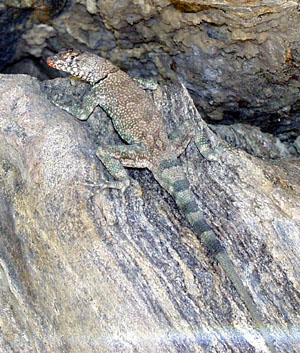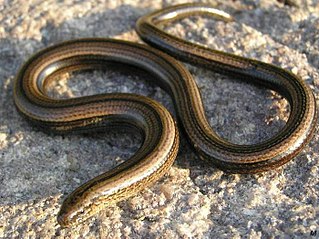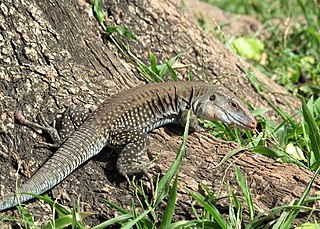
The family Anniellidae, known as American legless lizards, contains six species in a single genus Anniella: A. pulchra, the California legless lizard, the rare A. geronimensis, Baja California legless lizard, and four more discovered in 2013.

The slender glass lizard is a legless lizard in the glass lizard subfamily (Anguinae). The species is endemic to the United States. Two subspecies are recognized. The lizard was originally believed to be a subspecies of the eastern glass lizard. Their name comes from their easily broken tail which they can break off themselves without ever being touched. It is difficult to find a specimen with an undamaged tail. The lizard eats a variety of insects and small animals, including smaller lizards. Snakes and other animals are known to prey on the species. Humans have a part in destroying their environment and killing their food supply with insecticides. The lizard is considered to be a least-concern species according to the International Union for Conservation of Nature (IUCN), though it is vulnerable in Iowa and endangered in Wisconsin. It is important to note that the streamlined, legless species is often confused with snakes. Glass Lizards, however, differ from snakes as they possess a moveable eyelid, which is absent in snakes. Another way to distinguish glass lizards from snakes is the presence of an external ear opening, which are absent in snakes.

The western skink is a species of small, smooth-scaled lizard with relatively small limbs. It measures about 100 to 210 mm in total length. It is one of seven species of lizards in Canada. They spend much of their day basking in the sun. Their diet ranges widely, including spiders and beetles. Western skinks will bite if grasped and will flee if they feel threatened. It is a common but secretive species whose range extends from southern British Columbia and throughout Washington, Oregon, Nevada, Utah, Idaho, and Wyoming and into western Montana and northern Arizona and Missouri. They can also live in some areas of Texas It is widespread in northern California but primarily restricted to the coast in central and southern California. Found in a variety of habitats, this lizard is most common in early successional stages or open areas of late successional stages. Heavy brush and densely forested areas are generally avoided. Western skinks are found from sea level to at least 2,130 m (7,000 ft). This diurnal reptile is active during the warm seasons.

The western whiptail is a species of lizard in the family Teiidae. The species is found throughout most of the southwestern United States and northern Mexico. Most of its populations appear stable, and it is not listed as endangered in any of the states comprising its range. It lives in a wide variety of habitats, including deserts and semiarid shrubland, usually in areas with sparse vegetation; it also may be found in woodland, open dry forest, and riparian growth. It lives in burrows. Major differences between this species and the checkered whiptail include the lack of enlarged scales anterior to the gular fold and the presence of enlarged postantebrachial scales. It was previously known as Cnemidophorus tigris, until phylogenetic analyses concluded that the genus Cnemidophorus was polyphyletic. Since it does not migrate, a number of forms have developed in different regions, several of which have been given subspecific names – for example the California whiptail, Aspidoscelis tigris munda.

The flat-tail horned lizard is a species of lizard in the family Phrynosomatidae. A species of reptile, it is endemic to the Sonoran desert of the southwestern United States and northwestern Mexico. Its multiple adaptations for camouflage help to minimize its shadow. The species is threatened, with a restricted range under pressure from human activities such as agriculture and development, and is specially protected in the United States.

The granite spiny lizard is a species of lizard in the family Phrynosomatidae.

Petrosaurus mearnsi, also called the banded rock lizard, is a species of lizard in the family Phrynosomatidae. The species is native to western North America.

Legless lizard may refer to any of several groups of lizards that have independently lost limbs or reduced them to the point of being of no use in locomotion. It is the common name for the family Pygopodidae. These lizards are often distinguishable from snakes on the basis of one or more of the following characteristics: possessing eyelids, possessing external ear openings, lack of broad belly scales, notched rather than forked tongue, having two more-or-less-equal lungs, and/or having a very long tail.

The common Puerto Rican ameiva or Puerto Rican ground lizard is a species of lizard in the whiptail family.

Anniella pulchra, the California legless lizard, is a limbless, burrowing lizard often mistaken for a snake.
Isla San Martín is an island in the Pacific Ocean west of the Baja California Peninsula. The island is uninhabited and is part of the Ensenada Municipality.

Robert Cyril Stebbins was an American herpetologist and illustrator known for his field guides and popular books as well as his studies of reptiles and amphibians. His Field Guide to Western Reptiles and Amphibians, first published in 1966, is still considered the definitive reference of its kind, owing to both the quality of the illustrations and the comprehensiveness of the text. A professor of zoology at the University of California, Berkeley, for over 30 years, he was the first curator of herpetology at the Museum of Vertebrate Zoology, a 1949 Guggenheim fellow, and author of over 70 scientific articles. His discovery of the ring species phenomenon in Ensatina salamanders is now a textbook example of speciation, and he performed extensive research on the parietal eye of reptiles. He produced nature films, supported science education in primary grades, and organized conservation efforts that aided in the passing of the 1994 California Desert Protection Act. After retirement he continued to paint, collect field notes, and write books. Stebbins is commemorated in the scientific names of three species: Batrachoseps stebbinsi, the Tehachapi slender salamander; Anniella stebbinsi, a legless lizard; and Ambystoma tigrinum stebbinsi, the endangered Sonora tiger salamander.

The excitable delma is a species of lizard in the Pygopodidae family endemic to Australia. The lizard gets its name from its active and jumpy defense mechanism. It will erratically jump multiple times in succession, each jump pivoting its body in a different direction. D. tincta is a slender, long legless lizard that through evolution lost its limbs. It is found throughout Australia in a variety of habitats, and spends most of its time hiding. Due to its nocturnal nature, it is rare to spot in the wild. This legless lizard is small to moderate in size, with a tail that is three to four times its body length. The typical size of the excitable delma is 250 – 300 mm. This lizard is an insectivore and feeds on insects it finds when travelling through grass, logs, surface soil, and loose rocks. Like all pygopodids, the excitable delma is oviparous and only lays two eggs per clutch.

The Shark Bay worm-lizard, also known commonly as Harold's legless skink, is a species of lizard in the family Pygopodidae. The species is endemic to the Shark Bay region in Western Australia, Australia. It is a limbless lizard found burrowing in loose soil in arid areas.
The striated worm-lizard is a species of legless lizard in the family Pygopodidae. It is endemic to southern Australia. Commonly known as Striated worm-lizard but has also been referred to as the Striped or Lined worm-lizard due to its pattern of long, thin parallel streaks. Some populations such as those in WA and Kangaroo Island may have absent stripes or the lines present as lines of dots.

Tropicagama is a genus of large-bodied lizards in the family Agamidae. The genus is monotypic, with only one species listed: Tropicagama temporalis, commonly known as the swamplands lashtail or northern water dragon. This semi-arboreal species inhabits the tropical savannah woodlands of northern Australia, as well as parts of New Guinea and southeastern Indonesia.














